Late October
Affairs
|
|
Call
to register at (812) 474-1131 or (800) 782-6762!
Thu., Oct 18 -
6:30p.m. - Pizza, Family
Style - David Pampuch. $40. In this class, we'll watch David
make two different homemade crusts,  a "from-scratch" pizza sauce, the
very best freshly made Italian sausage, and three pizzas; including
the most authentic Chicago-style deep dish pizza available south of
the Calumet river. This is definitely NOT your typical chain
or restaurant deep-dish pizza. The homemade sausage recipe
alone is worth the price of the class. Bring a friend to this
one. This class is always filling, and always full! a "from-scratch" pizza sauce, the
very best freshly made Italian sausage, and three pizzas; including
the most authentic Chicago-style deep dish pizza available south of
the Calumet river. This is definitely NOT your typical chain
or restaurant deep-dish pizza. The homemade sausage recipe
alone is worth the price of the class. Bring a friend to this
one. This class is always filling, and always full!
Sat., Oct 20 -
9:30a.m. - Starts and
Finishes - Nicki Leathem. $38. Nicki is back in the kitchen
to teach us some Starts and Finishes. Be inspired by Scotch Eggs
that are fabulous for breakfast or brunch. The inspiration
continues with Shrimp Tartlets and Fruit Empañadas.
Finish up with Petit Fours, Sweet Potato Cheesecake with a
Gingersnap Crust, and the Hummingbird Package Cake.
Sun., Oct 21 -
1:30p.m. - Farmer's
Market Fall Flavors - Sara Gibbs. $43. Our menu includes
Honey Glazed Carrots, Parsnips & Currants, a Butternut Squash
Lasagne, (not vegetarian), some Rosemary Cabbage, a Thick Kale Stew,
(not vegetarian), Roasted Cauliflower, some Braised Fennel with
Parmesan, and for dessert, a Sweet Potato Gingerbread with Maple
Walnut Sauce. This class focuses on seasonal, locally produced
foods with very traditional cooking methods. This class is a
"classic!"
Tue., Oct 23 -
6:30p.m. - Pesce y
Pasta - Jillian Romano. $42. Starting with the Pesce Fritto,
a fried fish appetizer, we'll also dine on a homemade Tagliatelle
pasta with Sauce Ragú. Our
salad course is a Tomato and Olive creation, and for dessert we'lll
"suffer" through some Mascarpone with Almond Sauce.
Thu., Oct 25 -
6:30p.m. - Traditional
Cast Iron Cooking - Shelly Sackett. $42. Using seasoned bare
cast iron pans and enamel over cast iron pans, Shelly's menu begins
with a Spinach Salad with Hot Bacon Dressing served with Skillet
Corn Bread. The obvious choice for a main course is Fried
Chicken with Pan Cream Gravy that is so good you may never eat fast
food chicken again. This is served with Louisiana Never-Fail
Skillet Biscuits, and dessert is a Pineapple Upside-Down Cake.
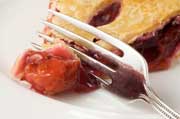 Sat., Oct 27 -
9:30p.m. - Desserts Buy
the Book - Deena Stovall. $50. Deena will be showcasing 3
recipes from her new cookbook: Amaretto Almond Cheesecake,
Cherry Pie with Ginger Whipped Topping and a Glazed Fresh Apple
Cake. Deena's expertise with desserts shines in her teaching
and in her book. Sat., Oct 27 -
9:30p.m. - Desserts Buy
the Book - Deena Stovall. $50. Deena will be showcasing 3
recipes from her new cookbook: Amaretto Almond Cheesecake,
Cherry Pie with Ginger Whipped Topping and a Glazed Fresh Apple
Cake. Deena's expertise with desserts shines in her teaching
and in her book.
Sun., Oct 28 -
1:30p.m. - Champagne
Chicken Holiday Dinner - Deena Stovall. $50. Our first course
will be a Spinach Roulade with a Shrimp Filling and served with a
Rich Shrimp Sauce. The main course is a Chicken Breast Baked
in a Champagne/Brandy Sauce: Not complicated, server friendly
and very rich and good. This is accompanied by Carrots
"Fettuccine," not a pasta, just a vegetable presentation you'll
enjoy. Our dessert is a Plum Spice Cake with Hard
Sauce.
Mon., Oct 29 -
6:30p.m. - Fall into
Flavorful Vegetables - Doug Rennie. $40. This menu is as
colorful as it is delicious as we enjoy a Winter Vegetable Curry and
a singular Gratin of Eggplant, Roasted Peppers, and Garlic.
We'll also delve into a Risotto made with Artichokes, Tomatoes,
Spinach and Thyme. Our dessert is a smooth and seductive
Chocolate Ganache Cake. |
November
Affairs
|
November is
scheduled to be a great time for classes at Kitchen Affairs. During
this month we celebrate the best of autumn and help you prepare for
the holidays with new skills and ideas. In addition to our
stellar cast of instructors, we're offering four Celebrity
Chef Classes, two by Chef Jean Pierre Augé and two by
Betsy Oppenneer.
Thu., Nov 1 -
6:30p.m. - Sunday Brunch
for the Family - Nicki Leathem. $38.
Fri., Nov 2 -
6:00p.m. - Celebrity
Chef Classes - Jean Pierre Augé
Pork Loin with
Pine Nuts. $60.
Sat., Nov 3 -
1:00p.m. - Celebrity
Chef Classes - Jean Pierre Augé
Turkey Breast
with Pears $70.
Tue., Nov 6 -
6:30p.m. - Big-Time Sushi
Class - Lelia Gentle. $65.
Wed., Nov 7 -
6:30p.m. - Celebrity
Chef Classes - Betsy Oppenneer
Holiday Yeast
Breads. $50.
Thu., Nov 8 -
6:30p.m. - Celebrity
Chef Classes - Betsy Oppenneer
Appetizer
Breads. $50.
Mon., Nov 12 -
6:30p.m. - Decorating
Christmas Cookies - Cathy Webb. $40.
Wed., Nov 14 -
6:30p.m. - Basic Knife
Skills - Ed Bartush. $50.
Thu., Nov 15 -
6:30p.m. - Autumn is for
Apples - Stephen Lee. $45.
Sat., Nov 17 -
9:30 to 5:00pm - Gingerbread
House All-Day Workshop - Cathy Webb. $100.
Sun., Nov 18 -
2:00p.m. - Kids Have a
Holiday Party '07 - Peg Neireiter. $35.
Mon., Nov 19 -
6:30p.m. - Snap for a
Holiday Dinner - Scott Schymik. $48.
Call
to register at (812) 474-1131 or (800)
782-6762! |
|
The
Bean
|
|
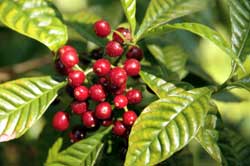 Legend has it
that Kaldi, a goat herder in the high plateaus of Ethiopia, noticed
his goats dancing after grazing on coffee shrubs. Kaldi tried the
red berries himself, and the coffee craze began circa 800
C.E. Coffee spread across the Red Sea to Arabia
where "bean broth" was brewed from the coffee beans.
Associated with enhancing "divine inspiration" during
religious rituals, the brew flourished throughout the
region. Seeking to maintain a monopoly on their
precious beans, Arabian coffee dealers boiled the beans before
exporting, rendering them infertile for planting. Not until 1600
when an Indian traveler, Baba Budan, smuggled live seeds out of
Arabia, were coffee plants grown anywhere else.
From Turkey to Italy, then the rest of Europe, the desire for
coffee grew geometrically. The Dutch, through
their colonization of Indonesian islands, industrialized coffee
production in the ideal tropical climate. Coveted
coffee sprouts surreptitiously found their way from Europe to
Central and South America as well. The introduction of coffee trees
to the Americas set the stage for mass production.
Finally there were enough beans for royalty and commoners
alike. (Resource: National
Geographic
- a fun illustrated resource on coffee intrigue). Legend has it
that Kaldi, a goat herder in the high plateaus of Ethiopia, noticed
his goats dancing after grazing on coffee shrubs. Kaldi tried the
red berries himself, and the coffee craze began circa 800
C.E. Coffee spread across the Red Sea to Arabia
where "bean broth" was brewed from the coffee beans.
Associated with enhancing "divine inspiration" during
religious rituals, the brew flourished throughout the
region. Seeking to maintain a monopoly on their
precious beans, Arabian coffee dealers boiled the beans before
exporting, rendering them infertile for planting. Not until 1600
when an Indian traveler, Baba Budan, smuggled live seeds out of
Arabia, were coffee plants grown anywhere else.
From Turkey to Italy, then the rest of Europe, the desire for
coffee grew geometrically. The Dutch, through
their colonization of Indonesian islands, industrialized coffee
production in the ideal tropical climate. Coveted
coffee sprouts surreptitiously found their way from Europe to
Central and South America as well. The introduction of coffee trees
to the Americas set the stage for mass production.
Finally there were enough beans for royalty and commoners
alike. (Resource: National
Geographic
- a fun illustrated resource on coffee intrigue).
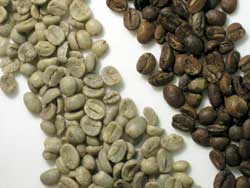 The
coffee tree thrives in tropical climates either side of the equator
where the plant finds a perfect compliment of sunshine, consistent
rainfall, and steady, near-70 degree temperatures.
Beans are roughly grouped by growing region: South American,
Central American, African, and Asia/Pacific.
Today, the top producing countries for beans are Brazil,
Colombia, and Indonesia. The
coffee tree thrives in tropical climates either side of the equator
where the plant finds a perfect compliment of sunshine, consistent
rainfall, and steady, near-70 degree temperatures.
Beans are roughly grouped by growing region: South American,
Central American, African, and Asia/Pacific.
Today, the top producing countries for beans are Brazil,
Colombia, and Indonesia.
Choosing excellent
coffee beans begins with distinguishing between the two main types
of coffee trees: Arabica and Robusta.
Arabica
beans, from the species,
Coffea arabica, comprise 75-80 percent of the available
coffee harvest. These trees thrive in higher
elevations, are less hardy, and produce less coffee than their
Robusta counterparts. But, despite these apparent
disadvantages, Arabica beans are much preferred for their milder
taste and greater aroma.
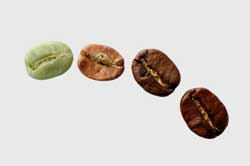 Robusta
beans, from the species,
Coffea canephora, make up the remaining 20-25 percent of
coffee beans. The hardier robusta tree grows at a
lower elevation producing twice as many beans per tree.
Unfortunately, Robusta beans produce a much inferior cup of coffee
with more sharp and bitter tastes compared to Arabica beans. Robusta
beans, from the species,
Coffea canephora, make up the remaining 20-25 percent of
coffee beans. The hardier robusta tree grows at a
lower elevation producing twice as many beans per tree.
Unfortunately, Robusta beans produce a much inferior cup of coffee
with more sharp and bitter tastes compared to Arabica beans.
After ensuring your
choices are from the Arabica family, your preferences will be
further driven by origin, blend and roast. Much
like fine wine, coffee beans will vary by country, grower, and
specialty varietals. Occasionally you will see offers of "peaberry"
coffee beans. Typically, a coffee cherry will
have two beans inside. A small percentage of
coffee cherries will have only one bean known as a
peaberry. Peaberries have a greater concentration
of flavor and less acidity than regular beans.
The rarity of peaberries will be reflected in its price.
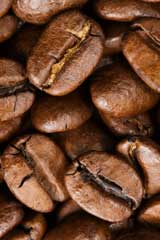 Once
harvested, and extracted from the coffee cherry, the beans are left
to ferment, then washed and dried. The resulting
green or raw beans are shipped through distribution systems to
coffee roasters. The type of roast applied to a
green bean will greatly impact the flavor outcome.
Roasting occurs at around 400 degrees F inducing a
complex process of caramelization changing starches into
sugars. As roasting continues, the sugars are
further reduced. With more time at the high
temperatures, oils will emerge from the bean. Once
harvested, and extracted from the coffee cherry, the beans are left
to ferment, then washed and dried. The resulting
green or raw beans are shipped through distribution systems to
coffee roasters. The type of roast applied to a
green bean will greatly impact the flavor outcome.
Roasting occurs at around 400 degrees F inducing a
complex process of caramelization changing starches into
sugars. As roasting continues, the sugars are
further reduced. With more time at the high
temperatures, oils will emerge from the bean.
Different Roasts
of Beans:
Cinnamon - light brown, dry, toasted grain flavor,
some sourness.
New
England - similar to
cinnamon though less grain flavor.
American Light - medium brown beans; a roast often used in
professional tasting situations.
Medium City - medium brown; showcases differences in
varietals.
Full City - medium dark brown beans, some oil on the
surface; caramel and chocolate undertones.
French - dark brown beans, shiny with oil, less
acidity. Often used for espresso.
Italian or Dark French - darker and oilier than French; somewhat
burned flavor.
Spanish - darkest roast of all; nearly black,
charcoal undertones.
Lighter roasts have
more aromatic oils and more caffeine, but may have more bitterness
from the caffeine. Darker roasts have less
caffeine and are considered to be
smoother. 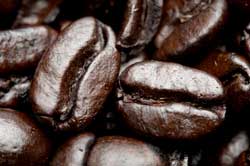 There
is no right or wrong choice of bean or roast, it's all about your
personal preference! There
is no right or wrong choice of bean or roast, it's all about your
personal preference!
Kitchen Affairs
carries over 30 varieties of coffee including more than a dozen
decaffeinated varieties, and half a dozen espresso roast
beans. All of our coffees are stored in glass to preserve the
flavor, and our inventory turns at least once a month, so our beans
are always fresh!
|
| Brewing a
Good Cup of Joe |
|
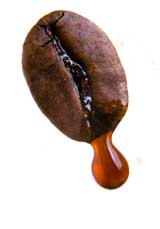 As lovely
as the 21,000-plus coffee shops in the U.S. are, they still
require proper attire. True heights in
coffee enjoyment can only be reached in one's pajamas and
slippers. There's something about
transitioning to wakefulness in the privacy of the home that
supersedes standing in a line first thing in the
day. With a plentitude of beans from
faraway places with nuanced roasts at the ready, we're on to
the brewing and enjoyment stage. At this
point it is all about freshness and timing! As lovely
as the 21,000-plus coffee shops in the U.S. are, they still
require proper attire. True heights in
coffee enjoyment can only be reached in one's pajamas and
slippers. There's something about
transitioning to wakefulness in the privacy of the home that
supersedes standing in a line first thing in the
day. With a plentitude of beans from
faraway places with nuanced roasts at the ready, we're on to
the brewing and enjoyment stage. At this
point it is all about freshness and timing!
Fresh
Beans -- Green beans
are bagged in burlap and shipped to coffee roasters around the
world. In their green state the beans last
for up to a year. Once roasted, however,
coffee beans should be used within just a few
weeks. This is where it pays to know your
vendor and their buying habits. Obtain your
beans from a retailer that has enough turnover in product and
conscientiously seeks good roasters with similar values around
freshness.
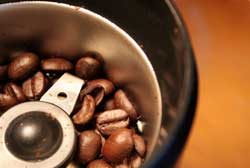 Grinding Whole Beans -- Grind freshly roasted coffee beans
immediately before brewing matching the fineness of the grind
to the type of brewing method. For example, a very fine,
powdery grind is needed for the preparation of Turkish-style
coffee, while a coarse grind would be appropriate for French
press methods where the coffee is steeped.
Fine and medium grinds are appropriate for drip methods
common to most automatic coffeemakers.
Electric coffee grinders such as Capresso,
Cuisinart,
and Krups
will prepare your beans to your desired grind.
A fine grind will result from 20-25 seconds in the
grinder, a medium or drip grind from 15 seconds, and a coarse
grind from 10 seconds. Grinding Whole Beans -- Grind freshly roasted coffee beans
immediately before brewing matching the fineness of the grind
to the type of brewing method. For example, a very fine,
powdery grind is needed for the preparation of Turkish-style
coffee, while a coarse grind would be appropriate for French
press methods where the coffee is steeped.
Fine and medium grinds are appropriate for drip methods
common to most automatic coffeemakers.
Electric coffee grinders such as Capresso,
Cuisinart,
and Krups
will prepare your beans to your desired grind.
A fine grind will result from 20-25 seconds in the
grinder, a medium or drip grind from 15 seconds, and a coarse
grind from 10 seconds.
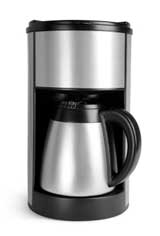 Drip
Brewing Machines -
Match your coffeemaker to your needs. When
buying a new coffeemaker consider the quantity of coffee you
would usually brew and size your machine accordingly. Evaluate
the overall ease of use of the machine's controls. Other
features to consider in a coffeemaker include: Drip
Brewing Machines -
Match your coffeemaker to your needs. When
buying a new coffeemaker consider the quantity of coffee you
would usually brew and size your machine accordingly. Evaluate
the overall ease of use of the machine's controls. Other
features to consider in a coffeemaker include:
(1)
Pause-to-Serve valve which allows pouring from the carafe
prior to completion of brewing,
(2) Auto-Off which we
consider a mandatory safety feature,
(3) Built-in Water
Filters reduce unwanted chlorine and iron from tap
water,
(4) Permanent Coffee Filters made from fine mesh
plastic or metal eliminate the need for paper filters and
avoids adding a paper taste to your coffee,
(5) Carafe
Styles may be glass, or thermal in nature,
(6) Timers often
come with coffeemakers, though setting up your brew the night
before, compromises both the freshness of the grind and the
quality of your water into a lesser flavored cup of
coffee,
(7) Single-serving brewing
machines have advanced significantly and may fit your
lifestyle,
(8) Combination machines from Cuisinart
accommodate both drip and pressurized espresso brewing save
counterspace and at a lower net investment than two machines.
We feature
several models of Capresso,
Cuisinart,
and Krups
coffeemakers and would be
happy to assess your needs and provide a
recommendation.
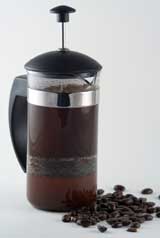 French
Press (Plunger Pots)
- A French press offers a simple alternative for brewing a
good cup of coffee. Coffee grounds are
placed in the glass carafe and near boiling water
added. The pot is fit with the lid and
plunger apparatus that presses the grounds to the bottom of
the pot after four minutes of steeping.
Serve immediately to avoid bitterness from over
extraction. French-pressed coffee allows
finer coffee particles and essential oils into the cup
providing a full-bodied experience. We
offer French press pots from Bodum
and
Bonjour. For peak flavor, a
French-pressed pot of coffee should be consumed within 15-20
minutes. French
Press (Plunger Pots)
- A French press offers a simple alternative for brewing a
good cup of coffee. Coffee grounds are
placed in the glass carafe and near boiling water
added. The pot is fit with the lid and
plunger apparatus that presses the grounds to the bottom of
the pot after four minutes of steeping.
Serve immediately to avoid bitterness from over
extraction. French-pressed coffee allows
finer coffee particles and essential oils into the cup
providing a full-bodied experience. We
offer French press pots from Bodum
and
Bonjour. For peak flavor, a
French-pressed pot of coffee should be consumed within 15-20
minutes.
Water - Since coffee is 97% water, it make
sense to pay attention to its quality.
Baristas recommend using filtered water, whose natural
mineral content adds to the coffee's flavor, yet has any
chlorine removed. Distilled water, void of
mineral content, should not be used for coffee.
Softened water is also not recommended for coffee
brewing. Add water to the coffeemaker just as you are
brewing. Water that has set loses some of
its natural oxygen and will produce a flat cup of coffee.
Measure - While coffee intensity is somewhat
a matter of individual taste, the rule of thumb is 2
tablespoons of coffee for each 6 ounces of water.
Brewing - With the ingredients staged, the
automatic coffeemaker will heat the water to just below its
boiling point, ideally between 203-208 F, or 95-98 C.
(Remember the maxim,
"coffee boiled is coffee spoiled").
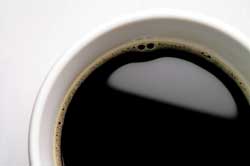 Employing
gravity, the heated water drips through the captive coffee
grounds activating aromas and flavors with its
heat. A pot of drip-brewed coffee should be
consumed within 30 minutes. Employing
gravity, the heated water drips through the captive coffee
grounds activating aromas and flavors with its
heat. A pot of drip-brewed coffee should be
consumed within 30 minutes.
Drinking -- Allow your nose to have the first
encounter with the fresh brew. With a
slight pause, take the first sip. The coffee is ready for
those who enjoy black coffee, or ready for further
personalization with cream, sugar and other
variants. | |
Espresso
Expressions
|
|
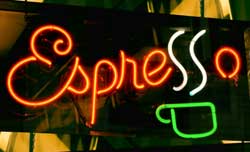 In the
scope of coffee history, espresso is a newcomer. Machines utilizing
steam pressure were developed in Italy in the
mid-1800's. However, it was not until the
mid-1900's that espresso machines using spring piston pressure
created commercial success for the elixir. In the
scope of coffee history, espresso is a newcomer. Machines utilizing
steam pressure were developed in Italy in the
mid-1800's. However, it was not until the
mid-1900's that espresso machines using spring piston pressure
created commercial success for the elixir.
Fundamentally
different in its brewing method and result, espresso is a
concentrated coffee drink that gathers the essence of the bean under
pressure. It is said that, "the perfect Espresso
can only be created by forcing water at 9 [atmospheres of] pressure
and 88 C degrees through a tightly compact wad of 8 grams of freshly
ground coffee beans, producing 1.7 fluid oz of coffee in exactly 22
seconds." -
KoffeeKorner.com
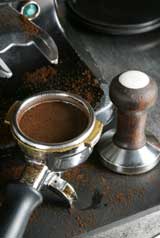 A
defining characteristic of espresso is its crema.
Lying atop an espresso, the reddish-brown crema is a foamy
emulsification of the coffee's oils, proteins and
sugars. An espresso begins to lose its character
quickly and should be enjoyed immediately. A
defining characteristic of espresso is its crema.
Lying atop an espresso, the reddish-brown crema is a foamy
emulsification of the coffee's oils, proteins and
sugars. An espresso begins to lose its character
quickly and should be enjoyed immediately.
Espresso
preparation is an art form studied and practiced by baristas
everywhere. Experts attribute the Perfect Espresso to (1) a balanced blend of beans, (2) a
complementary roast, (3) a fine, even grind accomplished just before
brewing, (4) the right amount of coffee (dosing), (5) proper tamping
techniques, (6) water quality, (7) water temperature, (8)
consistent, stabilized temperature, (9) water pressure, (10) boiler
pressure, (11) extraction time, (12) timeliness,
(13) machine cleanliness, (14) warmed cup, and (15)
practice!
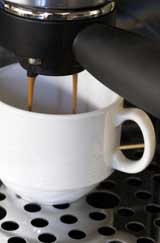 Espresso Machines - Several
excellent home espresso machines are available.
Consider the following characteristics when choosing a
machine: Espresso Machines - Several
excellent home espresso machines are available.
Consider the following characteristics when choosing a
machine:
(1)
Pressure source -
pump-driven, levered, or steam-driven
(2)
Size
(3)
Ease of use and
maintenance
(4)
Quality of brewed
result
We carry different
models of espresso machines from Krups and Capresso.
We look forward to discussing your options on your next visit.In
addition to espresso machines, we have a full line of other espresso
equipment: frothing pitchers, thermometers, and
demitasse cups.
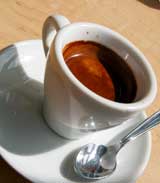 With espresso as
the base, a variety of exquisite concoctions emerge along with a new
vernacular for your everyday vocabulary: With espresso as
the base, a variety of exquisite concoctions emerge along with a new
vernacular for your everyday vocabulary:
Cappuccino - made from 1 shot of espresso (1/3) mixed
with equal parts of steamed milk (1/3) topped with an equal amount
of foamed milk (1/3) on top. Cinnamon or cocoa
powder are sometimes lightly dusted on the foamy
surface.
Latte - one shot of espresso (1/3) and twice the
amount of steamed milk (2/3). Spices and flavors
added to the base latte generate an endless number of different
pleasurable drinks.
Red
Eye - one shot of espresso
in a cup of drip coffee.
Macchiato - one shot of espresso with a dollop of
foamed milk on top.
Ristretto - An espresso with only half of the liquid
used;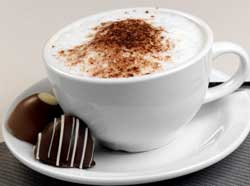 this
produces an even more concentrated drink, some say the sweetest part
of the coffee. this
produces an even more concentrated drink, some say the sweetest part
of the coffee.
Americano - one shot of espresso with one cup of hot
water.
Breve - one shot of espresso with warm light
cream.
Con
Panna - one shot of
espresso with a dollop of whipped cream on top.
Mochaccino - a cappuccino with chocolate syrup
added.
Romano - one shot of espresso with a twist of
lemon
peel.
|
Plan Ahead
Tips
|
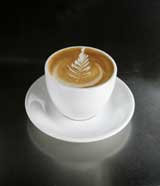 Tip
#1:
Practice the art of espresso making prior to entertaining,
then dazzle your friends with your adeptness.
Include a bit of latte art as part of your signature latte
preparation. This video clip will teach you some of the basic designs.
Join the World Barista
Championships with your new skill
set! Tip
#1:
Practice the art of espresso making prior to entertaining,
then dazzle your friends with your adeptness.
Include a bit of latte art as part of your signature latte
preparation. This video clip will teach you some of the basic designs.
Join the World Barista
Championships with your new skill
set!
Tip
#2: Host
a cupping! What a wine tasting is to wine,
cupping is to coffee. This is a great way to
become acquainted with different blends and roasts.
Cupping techniques and standards are employed by professional
roasters and buyers in comparing and evaluating beans and
blends. An experienced cupper evaluates the brew
according to its fragrance, aroma, taste, nose, aftertaste, and
body. This Cupping Form in PDF format will help get the party
started. For detailed cupping instructions visit
Sweet Maria's Reference
Information.
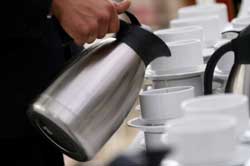 Tip
#3:
Ensure the quality of the next cup of coffee with a
scrupulously clean coffee machine. The oils in
coffee, like any oil, will become rancid through a natural oxidation
process and greatly affect your brew. Clean all
non-electric parts in the dishwasher regularly, and scrub other
parts to remove old oils and stains. Include that
favorite coffee mug in this regular cleaning routine as
well! In addition to improving your coffee,
regular cleaning will prolong the life of your
machine. Tip
#3:
Ensure the quality of the next cup of coffee with a
scrupulously clean coffee machine. The oils in
coffee, like any oil, will become rancid through a natural oxidation
process and greatly affect your brew. Clean all
non-electric parts in the dishwasher regularly, and scrub other
parts to remove old oils and stains. Include that
favorite coffee mug in this regular cleaning routine as
well! In addition to improving your coffee,
regular cleaning will prolong the life of your
machine.
|
Q &
A's
|
|

Q:
What is a
quaker?
A:
In the coffee
context, a quaker is an unripe or immature coffee bean.
After roasting, quakers appear pale and yellowish in
color. The percentage of quakers in a batch of
coffee beans will directly affect the quality of the coffee giving
it a bad taste. Quakers are easy to pick out of
bag of beans; check your batch before brewing.
Q:
How is coffee
decaffeinated?
A: Decaffeination processes
are typically water-based, or CO2-based. Water
processing consists of soaking the beans in water which dissolves
the caffeine in the bean. The beans are removed
and the caffeine is extracted from the water with solvents like
methylene chloride or ethyl acetate, or activated carbon. After the
caffeine and solvent have been removed from the liquid, the beans
are returned to the remaining liquid to reabsorb other coffee
compounds dissolved in the soaking process. During CO2 processing,
the green beans are separated from the caffeine with highly
compressed CO2.
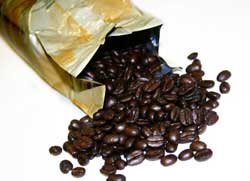 Q:
What is
the best way to store my coffee? Q:
What is
the best way to store my coffee?
A: Whole roasted beans may be stored at room
temperature in a dark place for 1-2 weeks. Ground
roasted coffee should be stored in an airtight container and used as
soon as possible. Contrary to popular belief,
coffee beans should not be stored in the freezer.
Metal and plastic containers should be avoided as they may
impart unwanted flavors; stick with glass or ceramic vessels.
Q:
My coffee bag has a
button on the side. What is
it?
A:
Coffee beans give
off CO2 as they sit. An increase of CO2
denigrates the beans. The little button is a
one-way valve that allows CO2 to escape without letting outside air
into the bag. The result is better
beans. |
Cookbook
Review
|
|
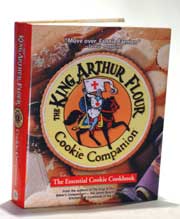 The King Arthur Flour® Cookie
Companion: The Essential Cookie
Cookbook The King Arthur Flour® Cookie
Companion: The Essential Cookie
Cookbook
Copyright ©
2004. The Countryman Press.
In the tradition of
the award-winning The King Arthur Flour Baker's Companion,
this cookie cookbook gathers realms of wisdom into one
volume. Cookies of all types are catalogued in
this encyclopedic volume. Step-by-step
instructions are augmented by detailed illustrations and luscious
photographs in a center inset. Particularly
helpful are the sidebars explaining techniques such as folding,
rolling, marbling and many other topics. In-depth
information on ingredients and baking tools provides further
education and expertise to bakers at all levels.
Our favorite aspect of this cookbook is the nutritional
information included at the end of each recipe.
While at first blush this would seem counterintuitive in a
cookie cookbook, it becomes an enabling aspect in making personal
choices and allows us to achieve moderation while still enjoying
some sweet treats! |
Recipes
|
|
A sweet morsel
pairs well with a cup of coffee. The classic
accompaniment to coffee or espresso is the biscotti.
Italian in origin, a good biscotti is not too sweet, is eaten
slowly, and occasionally dunked. Originally a biscuit made for
traveling, the Italian version of biscotti is denser and harder than
the lighter and crunchier American version. The difference is the
addition of butter in the American dough. We prefer the Italian
version slightly more than the American, but both styles are more
than adequate! From the basic dough, biscotti variations abound;
three variations are offered below. Easy to make, enjoy some
continental flair with your cuppa.
Access a printable version of the recipe (PDF format).
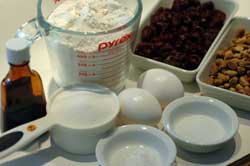 Italian-Style
Biscotti (Yields 14 to 16 biscotti) Italian-Style
Biscotti (Yields 14 to 16 biscotti)
2 large eggs
2/3
cup sugar
1/2 teaspoon baking powder
1/2 teaspoon salt
1
teaspoon vanilla extract
2 cups unbleached all-purpose flour
(1) Preheat the
oven to 350 degrees F. Lightly grease (or line
with parchment) a large (about 18 x 13 inch) baking sheet.
(2) In
a medium bowl, beat the eggs, sugar, baking powder, salt, and
vanilla until creamy looking; the mixture will be light-colored and
as thick as pancake batter. Lower the mixer speed
and add the flour, beating gently just until it's totally
incorporated.
(3) Transfer the dough to the prepared baking
sheet, and shape it into a rough log about 14 inches
long. It will be about 2.5 inches wide and about
3/4 inches thick. Smooth the top of the log with
a wet dough scraper.
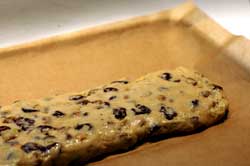 (4) Bake the
dough for 25 minutes. Remove from the oven and
let cool on the pan for 5 to 25 minutes. Five
minutes before cutting, use a spray bottle of room-temperature water
to lightly but thoroughly spritz the log, making sure to cover the
sides and the top. Softening the crust just this
little bit will make slicing the biscotti much easier. (4) Bake the
dough for 25 minutes. Remove from the oven and
let cool on the pan for 5 to 25 minutes. Five
minutes before cutting, use a spray bottle of room-temperature water
to lightly but thoroughly spritz the log, making sure to cover the
sides and the top. Softening the crust just this
little bit will make slicing the biscotti much easier.
(5) Reduce
the oven temperature to 325 degrees F. Wait
another 5 minutes, then cut the biscotti into 1/2 to 3/4 inch
slices. How thick you slice them depends on a
number of factors. This recipe, without nuts or
add-ins, is easy to slice thin. Once you add
chips, almonds, raisins, and other chunky ingredients, a 3/4-inch
slice is more realistic. When slicing, be sure to
cut straight up and down. If you cut biscotti
wider at the top than at the bottom, they'll topple over during
their second bake.
(6) Set the biscotti upright on the prepared
baking sheet. Bake for 25 minutes.
Remove from the oven and transfer to a rack to cool. Store
the biscotti in an airtight container, to preserve their
texture. If they aren't as hard as you'd like
(and the weather is dry), store them uncovered, overnight to
continue drying. Biscotti can be stored at room
temperature for 2 weeks; for longer storage, wrap airtight and
freeze.
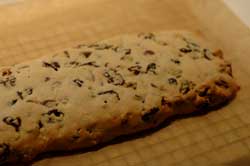 Nutrition
information per serving: (1 biscotti, 29g): 91
cal, 1g fat, 2g protein, 11g complex carbohydrates, 8g sugar, 27mg
cholesterol, 90mg sodium, 26mg potassium, 12 RE vitamin A, 1 mg
iron, 12mg calcium, 27mg phosphorous. Nutrition
information per serving: (1 biscotti, 29g): 91
cal, 1g fat, 2g protein, 11g complex carbohydrates, 8g sugar, 27mg
cholesterol, 90mg sodium, 26mg potassium, 12 RE vitamin A, 1 mg
iron, 12mg calcium, 27mg phosphorous.
American-Style
Biscotti
(Yields 14 to 16 biscotti)
6 tablespoons
unsalted butter
2/3 cup sugar
1/4 teaspoon salt
1 teaspoon
vanilla extract
1.5 teaspoon baking powder
2 large eggs
2
cups unbleached all-purpose flour
(1) Preheat the
oven to 350 degrees F. Lightly grease (or line
with parchment) a large (about 18 x 13 inch) baking
sheet.
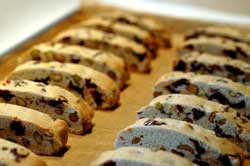 (2) In a medium
bowl, beat the butter, sugar, baking powder, salt, and vanilla until
the mixture is smooth and creamy. Beat in the eggs; the batter may
look slightly curdled. Lower the mixer speed and
add the flour, and mix until smooth. The dough
will be quite soft and sticky, but should hold its shape when you
drop it from a spoon. (2) In a medium
bowl, beat the butter, sugar, baking powder, salt, and vanilla until
the mixture is smooth and creamy. Beat in the eggs; the batter may
look slightly curdled. Lower the mixer speed and
add the flour, and mix until smooth. The dough
will be quite soft and sticky, but should hold its shape when you
drop it from a spoon.
(3) Transfer the dough to the prepared
baking sheet, and shape it into a rough log about 14 inches
long. It will be about 2.5 inches wide and about
3/4 inches thick. Smooth the top of the log with
a wet dough scraper.
(4) Bake the dough for 25
minutes. Remove from the oven and let cool on the
pan for 5 to 25 minutes. Five minutes before
cutting, use a spray bottle of room-temperature water to lightly but
thoroughly spritz the log, making sure to cover the sides and the
top. Softening the crust just this little bit
will make slicing the biscotti much easier.
(5) Reduce the oven
temperature to 325 degrees F. Wait another 5
minutes, then cut the biscotti into 1/2 to 3/4 inch
slices. How thick you slice them depends on a
number of factors. This recipe, without nuts or add-ins, is
easy to slice thin. Once you add chips, almonds,
raisins, and other chunky ingredients, a 3/4-inch slice is more
realistic. When slicing, be sure to cut straight up and
down. If you cut biscotti wider at the top than
at the bottom, they'll topple over during their second
bake.
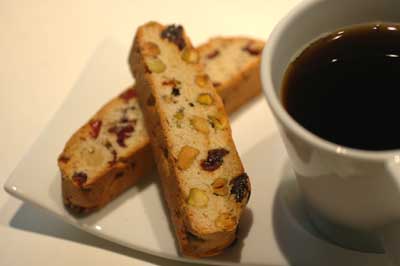 (6) Set
the biscotti upright on the prepared baking sheet.
Bake for 25 minutes. Remove from the oven
and transfer to a rack to cool. Store the biscotti in an airtight
container, to preserve their texture. If they
aren't as hard as you'd like (and the weather is dry), store them
uncovered, overnight to continue drying. Biscotti
can be stored at room temperature for 2 weeks; for longer storage,
wrap airtight and freeze. (6) Set
the biscotti upright on the prepared baking sheet.
Bake for 25 minutes. Remove from the oven
and transfer to a rack to cool. Store the biscotti in an airtight
container, to preserve their texture. If they
aren't as hard as you'd like (and the weather is dry), store them
uncovered, overnight to continue drying. Biscotti
can be stored at room temperature for 2 weeks; for longer storage,
wrap airtight and freeze.
Nutrition
information per serving: (1 biscotti, 35g): 131
cal, 5g fat, 2g protein, 11g complex carbohydrates, 8g sugar, 39mg
cholesterol, 88mg sodium, 27mg potassium, 54 RE vitamin A, 1 mg
iron, 30mg calcium, 35mg phosphorous.
Pistachio-Cherry
Biscotti
(Yield 16 to 18 biscotti)
Golden-green,
mildly salty pistachios and deep red, sweet and tangy dried cherries
complement each other beautifully, both in color and flavor.
1 recipe Essential
Biscotti (Italian-Style, or American-Style)
2 drops strong cherry
flavor (optional)
1 cup chopped pistachios
1 cup sweet or sour
dried cherries
(1) Preheat the
over to 350 degrees F. Lightly grease (or line
with parchment) a large (18 x 13 inch) baking sheet.
(2) Prepare
the biscotti dough of your choice, substituting the cherry flavor
for the vanilla, if desired. Stir in the
pistachios and cherries. Shape and bake the
biscotti as directed in the recipe you've chosen.
If the cherries are very fresh and moist, the biscotti may be
fairly soft at the end of the baking time. For
crunchier biscotti, bake for an additional 5 to 10
minutes.
Cranberry-Orange
Biscotti
(Yield 16 to 18 biscotti)
This classic muffin
and quick bread flavor pairing translates beautifully to
biscotti. These make a lovely dessert at
Thanksgiving, if you can tear folks away from the pumpkin
pie. Measure the orange zest into the tablespoon
without packing it. It takes about half a large
orange to yield a tablespoon of zest.
1 recipe Essential
Biscotti (Italian-Style, or American-Style)
2 tablespoons orange
juice
1 tablespoon grated orange rind (zest)
1 cup dried
cranberries
1 cup chopped walnuts, toasted
(1) Preheat the
over to 350 degrees F. Lightly grease (or line
with parchment) a large (18 x 13 inch) baking sheet.
(2) Prepare
the biscotti dough of your choice, adding the orange juice and zest
once the egg/sugar mixture is fully beaten. Stir in the cranberries
and walnuts along with the flour. Shape and bake the biscotti as
directed in the recipe you've chosen.
Brown
Sugar-Cinnamon Biscotti (Yield 16 to 18
biscotti)
These comforting
biscotti remind us of cinnamon toast. If you
can't find cinnamon chips at the supermarket, substitute
butterscotch chips.
1 recipe Essential
Biscotti (Italian-Style, or American-Style)
2/3 cup brown
sugar
2 teaspoons cinnamon
1 cup cinnamon chips
1 cup
chopped walnuts, toasted (optional)
(1) Preheat the
over to 350 degrees F. Lightly grease (or line
with parchment) a large (18 x 13 inch) baking sheet.
(2) Prepare
the biscotti dough of your choice, substituting the brown sugar for
the granulated sugar. Stir in the cinnamon,
cinnamon chips, and walnuts along with the flour.
Shape and bake
the biscotti as directed in the recipe you've chosen.
Excerpted from
The King Arthur Flour Cookie Companion: The Essential Cookie
Cookbook, © 2004 by King Arthur Flour Company, Inc.
Reprinted with permission of the publisher, The Countryman
Press/W.W. Norton & Company, Inc. To order, call
1-800-245-4151. | |